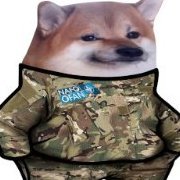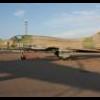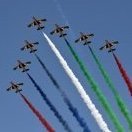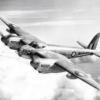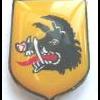

-Neu-
Members-
Posts
1,025 -
Joined
-
Last visited
Profile Information
-
Gender
Male
-
Location
Canada
Recent Profile Visitors
4,291 profile views
-Neu-'s Achievements

Very Obsessed Member (5/9)
584
Reputation
-
It clears a lot of procedural issues that will likely decrease the cost of the aircraft per unit - the biggest one is opening up the Multi-year buy pathway that may drop it from 2 to 15%.
-

50+ year old jets designs still in service
-Neu- replied to Nigel Bunker's topic in Aircraft Cold War
Honestly? there aren't many. Running a 50 year old plane is tough for so many reasons - they've either been superseded in doctrine or technology (or both). For the former, stuff like the F-111 was designed with the 1960s nuclear battlefield in mind, where very low level penetration was the only way to survive an ingress with a new generation of Soviet SAMs - you're paying a lot of money for a capability (low level supersonic dash) that is no longer valuable. Furthermore platforms from that era (1960) is just so far behind the cutting edge of technology - they're economically prohibitive and much less capable than modern platforms. Think about civil airliners - I suspect that the per seat cost for an passenger for a flight by a 737-200 vs a MAX is conservatively 50% less, if not significantly more. The only one in my mind that does not fit this criteria is the S-3 - the need for a carrier-capable long range ASW aircraft (that can double up doing tanker gas), would still be valuable today. -
If I remember correctly the A model was the most accurate of all of the ones Fujimi made - just the panels/features and the like most fit an A-model, then it went down in accuracy from there for each version (A+/B, D). They make into nice kits however - they had a lot of bells and whistles as someone noted above - a full engine with display trolly, pilots, a landing gear at full compression and at normal, droppable flaps. Obviously FM and then Hasegawa made superior kits for details, but Fujimi sorta hit the sweet spot in terms of accuracy, details, and fun. (sorry for the old photos, I don't have the kit here with me..) - This is the Hasegawa kit by comparison: They're all fun kits, but if you aren't looking for the most hyper accurate/detailed version, I'd actually go with fujimil, especially if you can find someone trying to offload it at a discount.
-
Ejecting cuts the engine fuel (apparently).
-
So to start, while I haven't seen the report in question, I can kinda guess the tack they're taking on their reporting by the facts you're presenting here. These sorts of reports are somewhat common in countries that just acquired the F-35 are trying to make a story out of something they don't fully grasp. That's not meant to be dismissive of the F-35's issues, but I sorta doubt the journalists who put together this piece have been watching the F-35's development for the past three decades and understand the context of what they're saying. We had the same thing happen in Canada years ago, and it was one of the factors behind the acquisition being cancelled in 2010 and 2014. The F-35 does have technical issues, but like someone posted above, most of them are fairly minor, and these are common among all major fighter programs. The numbers they cite are from the spring 2021 GAO report - the total number is around 800 now, but just under 200 are actually capability enhancements - ie the system works as required but the services want something changed to improve its function. The six "serious" ones (known as Category 1), were never ones that should "Ground" the fleet, which would make them Category 1A - they were all category 1B, and all but one I believe are resolved or close to it. A bunch of them related to gun vibration issues on the A, an overpressure situation during some maneuvers, and the lightning strike issue. The acquisition cost of the aircraft is basically in line with what was predicted when the aircraft entered its development phase - about $85M USD a copy - Germany is not a partner nation of the JSF program, so it has to pay for whats known as the Foreign military Sales fees (and non-recurring research fees) - so that increases the aircraft cost - I believe the non-recurring flyaway+FMS for the Luftwaffe is around 100M USD. At that cost its around what a Eurofighter costs. The F-35 is more costly to operate than was expected - perhaps 20% more than what was predicted in 2010. That's been a major area that the US government has tried to improve, and its been falling. ITs still less costly to operate than the Eurofighter, and is much more capable - you need fewer aircraft to do the same job. That's sorta been the trend since the first world war - fewer aircraft that cost more but can do the same job more effectively.
-
I've been ordering as much stuff through Ukrainian stores as possible, including Reskit stuff (UM, ACE, ect). Every little bit helps.
-
Yes, but if there's excessive maintenence requirements, or parts don't arrive on time (A perennial issue for the RAAF with European procurements), the cost goes up because people aren't flying, and they're sitting around doing nothing, while other platforms have to take up the gap. The 295 is not even close to comparable aircraft, they are significantly slower, have much less range and carrying capacity. Passable for light work, but totally inadequate for the roles that the RAAF will use them for. Exhibit A is the disaster that is the RCAF's Fixed Wing SAR program: there's a very high likelihood that he entire $2B CAD purchase will be scrapped because the C-295 is totally insufficient for the AF's needs, and its forced to used C-130Hs to fill the gap. Its a glorified ATR, not a tactical lifter.
-
There isn't a program of record at the moment for an aircraft to replace the C-130J and the J model is a modern aircraft as any other: they'll be operating it for 20~30 years with no problems or regrets. It also fits their force structure better, with eight C-17s and a dozen J models basically sharing the strategic and tactical workloads. Also the RAAF has zero confidence in European programs after the Tiger and Attack debacles, so the Atlas isn't really in the cards at all.
-

Camouflaged Alaskan F-16 Aggressors armed with live missiles for QRA.
-Neu- replied to Stephen's topic in Real Aviation
Intercept speed doesn't really matter that much - there's usually enough forewarning to get aircraft ready to go. The RCAF's squadrons are deployed well south, but have to transit several hours to a northern FOL and stage out of there if they do an intercept. Its really range and endurance that matters in these intercepts, so having tankers is a must. -

Camouflaged Alaskan F-16 Aggressors armed with live missiles for QRA.
-Neu- replied to Stephen's topic in Real Aviation
There hasn't been F-15s since about 2009 - the Alaskan defence mission has been mostly F-22s or CF-18s for the past decade. -

Italeri/Testors YF-23 1/72 modifications
-Neu- replied to Miloš77's topic in Work in Progress - Aircraft
Hey Milos I know you've already chosen a path, but I thought it might help offering a different perspective. I frequently have to do this modification, as I build a lot of in-flight aircraft and Hornets are a somewhat frequent build of mine. I like to use the hasegawa kit (its cheap, plentiful and does the job I need it to do), but it has a blanked intake like yours. So what I do is use miliput and a simple mold to wrap it around (basically a tube that sorta replicates the shape of the intake), which I quickly remove. I let it dry, then use some mr Surfacer 1000 to fill any cracks. file and sand it and its done. I've used generic fan blades faces that I've saved from the spares box in one other case (an F-4), in case you want to get fancy. Just some thoughts for future reference. -
Built the Italeri boxing pretty recently, its a bit of a mixed bag. Raised panel lines are problematic if that's your thing, and there's almost no detail on the forward fuselage underneath the cockpit, which is strange given how much detail there is on the upper half of the aircraft... cockpit isn't great at all (not that noticeable with a pilot), Fit is okay overall but the forward fuselage area is a bit fiddly, especially on the seamline that connects it to the landing gear area. I think the kit is satisfactory overall - for beginners its easy enough, for more experienced modellers, It just needs a bit of extra work to get it looking really good. I sorta wanted to get it done pretty quick so I made a lot of shortcuts, and I'm fine with what came out.
-

Like Teens Driving Ferraris: The CF-18 in RCAF Service (1/72 various)
-Neu- replied to -Neu-'s topic in F/A-18 STGB Part 2
Alright, I guess its time I started on this. So as I promised, I'm going to do a history and a build. I may well tack on a few more aircraft if I burn through the first two quick enough. It will likely be a rare configuration for the CF-18 Fleet - a somewhat short-lived upgrade path of the CF-18s during the 1990s and early 2000s known as War PGM (or WPGM) that I'll get into the history of. So as I mentioned I'm building this for a friend of mine. I'm going to be careful because I don't want to name this person. I suspect however RCAF people might figure out who it is. I did however make an error - he never sent me the B model tail that he wanted, only for his favourite 104 and a single seater. With the Canadian GB coming up I might save the 104 for that. So for this thread, I might just focus at the start on the single seat he loved - 188723 or Tail 723. I'll build the B model on the ground and not part of the display, perhaps the the aircraft in the photo above. Thats fine, because I didn't want to use one of my really precious pilot figures that are now OOP. On that note, for the kits, I'm using the hasegawa kit as mentioned earlier. They're not great, but not terrible. Because I'm making an in-flight display a lot of their big weaknesses aren't as apparent - molded horizontal stabs and other control surfaces don't really matter. I'll have to scratchbuild the upgraded identification lamp, but that's not a big deal as I've learned a better way of doing it over the years. I *may* scratch build intake trunkings too. I'm going to use a OOP decal set from Canuck decals - by David Winter. These were phenomenal decal sets and I've used a ton of them over the years. Unfortunately he closed up shop a few years ago and what few decals I do have I'm basically in hoarding stage. I may try to cannibalize already used sheets to keep my last symmetrical markings set intact for something else. As I mentioned before, the pilot set will be from Modern Hobbies, a company that also went out of business a few years ago. I use a lot of pilot figures for kits and his was the best for modern USAF/RCAF pilots, bar none. I have four pilots remaining, and I really didn't want to use more than one but I was prepared to do so. Well that's it for now. thanks for stopping by. I think the next one will be me starting on the kit, followed by the decision to acquire the CF-18 by the RCAF. -
Apparently only the pilot was killed, everybody else was treated for their injuries, thankfully.

